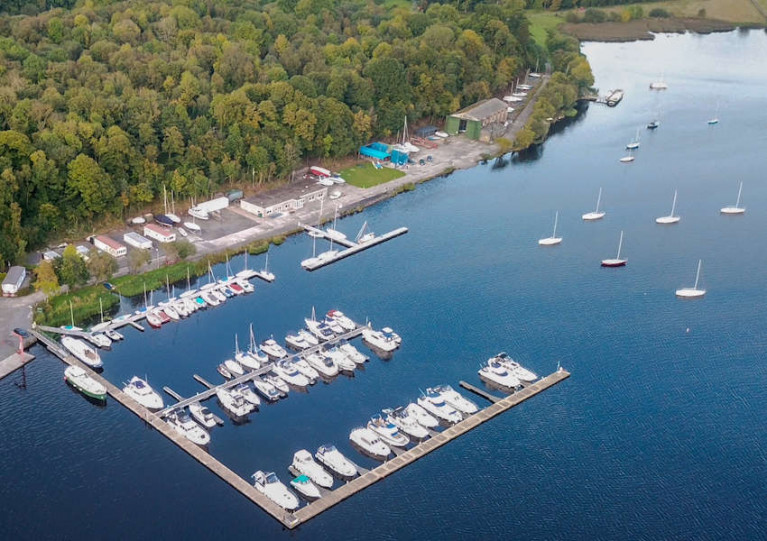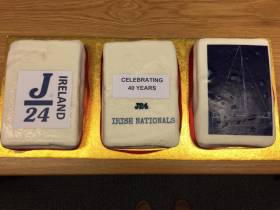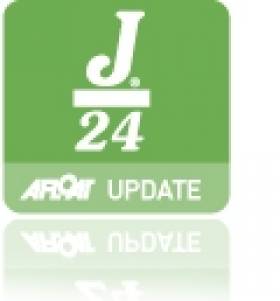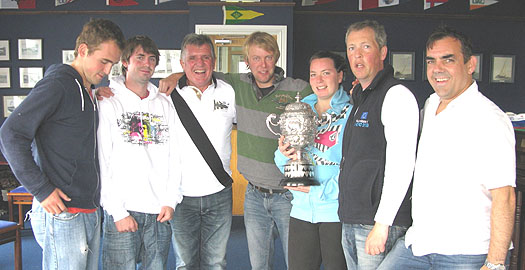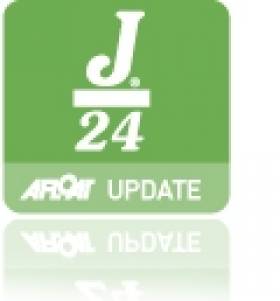Displaying items by tag: Lough Erne Yacht Club
12 teams travelled from throughout Ireland to compete in the 2022 J24 Northern Championships hosted by Lough Erne Yacht Club over the weekend of 18th and 19th June.
Four local boats including Barry Humphreys on TJ, Tim Rippey on Jigalo, Luke Mcbride on Crazy horse and JP McCaldin on Il Riccio took part.
Racing on Lower Lough Erne from the Lough Erne Yacht club the teams completed all 6 races over the weekend in strong winds on the broad lough. Racing was overseen by national race office Derek Bothwell and a team of volunteers on and off the water.
Race one on Saturday afternoon started in 24 knots of wind and was a very close contest with the lead changing several times the race eventually going to local team Il Riccio led by JP McCaldin, second was the new owner of Hard on Port from Bray sailing club Dave Bailley, with Diarmaid Mullen, Sligo Yacht Club, in third position with his new boat to the class Smugairle Róin and close battles down the fleet for the other places.
Race two went to Class president Mark Usher from Greystones sailing club sailing Jumpin’ Jive again with second place going to Hard on port and Il Riccio in third.
Race three saw Hard on Port take their first race win with Jumpin’ Jive in second position and Colm O’ Flaherty and team in their new boat Jedi from Sligo Yacht club coming third.
With the wind increasing again, Hard on Port dominated race four to take the win from Il Riccio with Smugairle Róin in third. Very tired, battered, and bruised sailors retired to the clubhouse in Killadeas for an evening of entertainment and to swap tails of the days epic racing in strong winds and sea-like waves. The seen was set on Sunday for an exciting two-race showdown between Hard on Port, Il Riccio and Jumpin Jive all separated by just 3 points any one of them could still take the event.
Sunday dawned calmer but by the time the teams arrived in the sailing area winds were again as strong as the previous days and small jibs were the order of the day to keep the boats under control.
Race 5 was again a battle between Hard on Port and Il Riccio. Il Riccio needed to beat Hard on Port to keep their event hopes alive and were leading at mark 1 but great speed by Hard on Port saw them take the lead win the race and their tight controlling position over Il Riccio allowed Jumpin Jive through to take 2nd from Il Riccio. This result meant Hard on Port took their first event win under Dave Bailey with a race to spare and left the rest to battle it out for the final race.
The final race was dominated by Il Riccio who stuck with the smaller jib, Smugairle Róin also stuck with their jib and came 2nd with Jumpin Jive third. This result meant Il Riccio finished 2nd overall with Jumpin Jive in 3rd. 1st silver fleet and under 25 team went to Howth under 25 team on Killcullen lead by Oisin O’ Connor, definitely a team to watch for the future.
Back to the clubhouse to de-rig and ready for the long drive home for all the travelling teams.
The J24 Northern Champion for 2022, Dave Bailey who said “delighted to get the win in very challenging conditions over the weekend. A great start to the season and looking forward to the events ahead throughout Ireland. The event was run superbly from start to finish as always by LEYC. More great memories to add to our sailing up North”.
At the prizegiving, event organiser June Clarke thanked event sponsors and wished everyone a safe journey. The class looks forward to its National championships in Foynes Yacht Club in July.
Notice of Diving Operations at Lough Erne Yacht Club
Waterways Ireland advises masters of all craft that diving operations will take place at Lough Erne Yacht Club on Lower Lough Erne from Monday 4 January for around seven days.
A diving alpha flag will be present at the location of the dive site, and masters of vessels on the inland waterway should proceed with additional caution when in the area.
Steady Wind Fails To Blow On Day 2 Of J24 Nationals
In complete contrast to Day 1, the forecasted steady wind of 10-15 knots failed to materialise on Day 2 of the J24 Nationals at Lough Erne Yacht Club, writes Elaine O’Mahoney.
Race 5 started on schedule yesterday (Saturday 24 August) in about 8 knots of wind but died just after boats round the first weather mark.
It then became a battle to find the brief and small patches of breeze scattered around the race course.
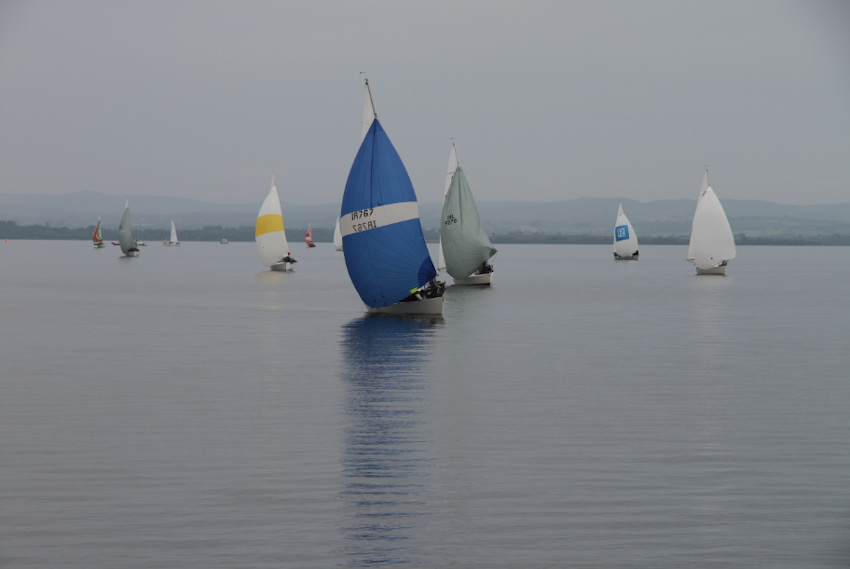 Boats becalmed on Lough Erne yesterday at the J24 Nationals
Boats becalmed on Lough Erne yesterday at the J24 Nationals
Just four boats made it back up to the weather mark on the second beat to complete the race within the time limit.
Racing for the day was then abandoned. This race will feature as the discard for most of the fleet. Results so far can be found HERE.
Lough Ree, Tralee Bay, Howth & Lough Erne To Host J/24 Championships In 2019
The J/24 Association of Ireland has announced the calendar for its regional and national championships in 2019.
Lough Ree Yacht Club will host the class for its Westerns in the first big event of the year on the weekend of 13-14 April — the week before Easter.
The following month the fleet moves to Tralee Bay Sailimg Club for the Southerns on 25-26 May.
Howth Yacht Club will host the Eastern Championship on 15-16 June, and the Nationals on 23-25 August will be sailing out of Lough Erne Yacht Club.
Change of J24 Leader as Big Winds Sweep Through Lough Erne
#j24 – Day two of the Irish J24 National Championships made for a gruelling affair for the competitors as winds gusted above 25 for most of the racing day writes Andrew Carey.
With it brought a change to the leaderboard with Flor O'Driscoll's Hard On Port taking line honours in the first two races of day two.
Unfortunately for the leader after day one, JP McCaldin's Jamais Encore, retirement from race one due to a damaged rudder meant that running repairs were called for as the fleet raced on in race two, but tantamount to the resolve of the Lough Erne boat, JP and his crew returned to take line honours in the final two races of the day.
With heavy winds and squalls rolling in off the north western shores, the 12 crews took their punishment as the country's best J24 boats battled and vowed for the lead which changed throughout the tight racing.
With 6 races sailed, Hard On Port has the lead by three points over Stefan Hyde's Hamilton Bear and Jamais Encore and further eight points back.
With two races to sail on the last day, close racing will again be to the fore as the top boats battle it out for the national J24 title.
Results after 6 raced
Hard on Port Flor O'Driscoll RsGYC
Hamilton Bear Stefan Hyde RCYC
Jamais Encore JP McCaldin LEYC
Kilcullen Gordon Stirling HYC
Crazy Horse Tim Corcoran SYC
J24s Off To A Blustery Start at Lough Erne Yacht Club
#j24 – Day one of the J24 Irish Nationals at Lough Erne Yacht Club got off to a blustery start in the Northern club yesterday as winds gusting up to 25–knots challenged the fleet of a dozen boats for honours over the first round of the three day event.
After two races, local boat Jamais Encore helmed by JP McCaldin has the jump on the fleet with a win in the first race followed by a 4th in race two as conditions settled.
Tight racing was the order of the day as the lead boats chopped and changed throughout the race legs. Race two honours went to Tim Corcoran at the helm of Crazy Horse from Sligo Yacht Club.
Overall, the top five boats in the class are separated from each other by just one point - Jamais Encore (JP McCaldin LEYC), Hamilton Bear (Stefan Hyde RCYC), Jellignite (Finbar Ryan LRYC), Crazy Horse (Tim Corcoran SYC) and Django (Martin MacNamara RWYCI / LRYC.
#yachtclubs – The antiquity of Irish recreational sailing is beyond dispute, even if arguments arise as to when it started, and whether or not the Royal Cork YC really is the world's oldest club in its descent from the Water Club of the Harbour of Cork from 1720. But all this seems academic when compared with the impression made by relics of Ireland's ancient sailing traditions.
In just six short years, the Royal Cork Yacht Club will be celebrating its Tercentenary. In Ireland, we could use a lot of worthwhile anniversaries these days, and this 300th has to be one of the best. The club is so firmly and happily embedded in its community, its area, its harbour, in Munster, in Ireland and in the world beyond, that it is simply impossible to imagine sailing life without it.
While the Royal Cork is the oldest, it's quite possible it wasn't the first. That was probably something as prosaic as a sort of berth holder's association among the owners of the ornamental pleasure yachts which flourished during the great days of the Dutch civilisation in the 16th and 17th Centuries. They were based in their own purpose-built little harbours along the myriad waterways in or near the flourishing cities of The Netherlands. Any civilisation which could generate delightful bourgeois vanities like Rembrandt's Night Watch, or extravagant lunacies such as the tulip mania, would have had naval-inspired organised sailing for pleasure and simple showing-off as central elements of its waterborne life.
Just sailing for pleasure and relaxation, rather than going unwillingly and arduously afloat in your line of work, seems to have been enough for most. Thus racing – which is the surest way to get some sort of record kept of pioneering activities – was slow to develop, even if inter-yacht matches were held, particularly once the sport had spread to England with the restoration of Charles II in 1660.
Ireland had not the wealth and style of either Holland or England, but it had lots of water, and it was in the very watery Fermanagh region that our first hints of leisure sailing appeared. It's said of Fermanagh that for six months of the year, the lakes are in Fermanagh, and for the other six, Fermanagh is in the lakes. Whatever, the best way to get around the Erne's complex waterways system, which dominates Fermanagh and neighbouring counties, was by boat. By the 16th Century Hugh Maguire, the chief of the Maguires, aka The Maguire, had a Lough Erne-based fleet, some boats of which were definitely for ceremonial and recreational use.
Sport plays such a central - indeed total - role in Irish life that it's highly likely these pleasure sailing boats were sometimes used for racing. However, the first recorded race anywhere in Ireland took place in Dublin Bay in 1663 when the polymath Sir William Petty, having built his pioneering catamaran Simon & Jude, then organised a race with a Dutch sailing vessel and a local "pleasure boatte" of noted high performance. This event, re-sailed in 1981 when the indefatigable Hal Sisk organised the building of a re-creation of the Simon & Jude, resulted both times in victory for the new catamaran. But because a larger sea-going version of the Simon & Jude, called The Experiment at the suggestion of Charles II himself, was later to founder with all hands while on a testing voyage in the Bay of Biscay, the multi-hull notion was abandoned in Europe for at least another two centuries.
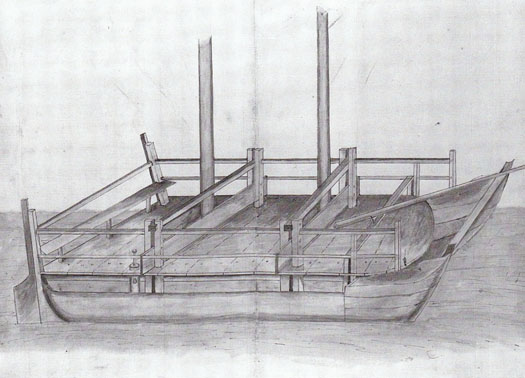
Contemporary drawing of the 17th Century catamaran Simon & Jude, which was built in Dublin and tested in the bay in an early "yacht race" in 1663.
We meanwhile are left wondering just what was this "pleasure boatte" was, and who owned and sailed it. Its existence and good sailing performance seems to have been accepted as unremarkable in Dublin Bay, yet no other record or mention of it has survived.
It was the turbulent life of Munster in the 17th Century which eventually created the conditions in which the first yacht club was finally formed. As the English Civil War spread to Ireland at mid-Century with a mixture of internecine struggle and conquest, the Irish campaigner Murrough O'Brien, the Sixth Baron Inchiquin, changed sides more than once, but made life disagreeable and dangerous for his opponents whatever happened to be the O'Brien side for the day.
Yet when the forces supporting Charles II got back on top in 1660 after the death of Cromwell in 1658, O'Brien was on the winning side. As the dust settled and the blood was washed away, he emerged as the newly-elevated Earl of Inchiquin, his seat at Rostellan Castle on the eastern end of Cork's magnificent natural harbour, and his interests including a taste for yachting acquired with his new VBF Charles II.
But there was much turmoil yet to come with the Williamite wars in Ireland at the end of the 17th Century. Yet somehow as the tide of conflict receded, there seemed to be more pleasure boats about Cork Harbour than anywhere else, and gradually their activities acquired a level of co-ordination. The first Earl of Inchiquin had understandably kept a fairly low profile once he got himself installed in his castle, but his descendants started getting out a bit and savouring the sea. So when the Water Club came into being in 1720, the fourth Earl of Inchiquin was the first Admiral.
In the spirit of the times, having an aristocrat as top man was sound thinking, but this was truly a club with most members described as "commoners", even if there was nothing common about their exceptional wealth and their vast land-holdings in the Cork Harbour area. Much of it was still most easily reached by boat, thus sailing passenger vessels and the new fancy yachts interacted dynamically to improve the performance of both.
Yet there was no racing. Rather, there was highly-organised Admiral Sailing in formation, something which required an advanced level of skill. However, many of the famous club rules still have a resonance today which gives the Water Club a sort of timeless modernity, and bears out the assertion by some historians that, as it all sprang to life so fully formed, the formation date of 1720 must be notional, as all the signs are that there had been a club of some sort for years beforehand.
But either way, it makes no difference to the validity or otherwise of the rival claim, that the Squadron of the Neva at St Petersburg in Russia, instituted by the Czar Peter the Great in 1718 to inculcate an enthusiasm for recreational sailing among Imperial Russia's young aristocrats, was the world's first yacht club. It was no such thing. It was in reality a unit of the Russian navy, and imposed by diktat from the all-powerful ruler. As such, it was entirely lacking the basic elements of a true club, which is a mutual organisation formed by and among equals.
Yet as the Water Club of the Harbour of Cork had no racing with results published in what then passed for the national media, we are reliant on the few existing club records and some travel writing from the time for much of our knowledge of the early days of the Water Club. That, and the Peter Monamy paintings of the Water Club fleet at sea in 1738.
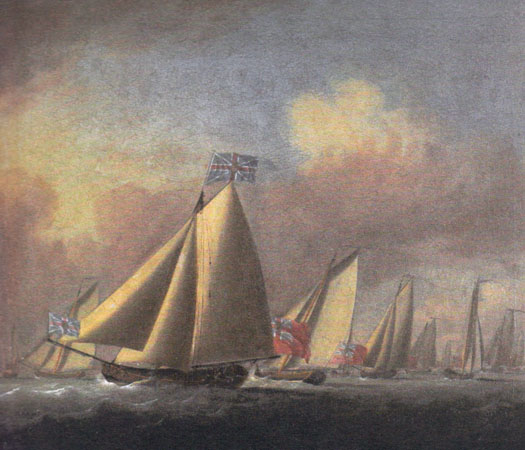
A remarkably well-disciplined fleet. Peter Monamy's 1738 painting of the yachts of the Water Club at sea off Cork Harbour. They weren't racing, but were keeping station in carefully-controlled "Admiral Sailing". Courtesy RCYC
Fortunate indeed are the sailors of Cork, that their predecessors' activities should have been so superbly recorded in these masterpieces of maritime art. The boats may look old-fashioned to a casual observer, yet there's something modern or perhaps timeless in this depiction of the fleet sailing in skilled close formation, and pointing remarkably high for gaff rigged boats as they turn to windward. Only a genuine shared enthusiasm for sailing could have resulted in such fleet precision, and in its turn in a memorable work of art. It is so much part of Irish sailing heritage that we might take it for granted, but it merits detailed study and admiration no matter how many times you've seen it already.
Shortly after Monamy's two paintings were completed, Ireland entered a period of freakish weather between 1739 and 1741 when the sun never shone, yet it seldom if ever rained, and it was exceptionally cold both winter and summer. It is estimated that, proportionately speaking, more people died in this little known famine than in the Great Famine itself 104 years later. While the members of the Water Club would have been personally insulated from the worst of it, the economic recession which struck an intensely agricultural area like Cork affected all levels of society.
Thus the old Water Club saw a reduction in activity, but though it revived by the late 1740s, the sheer energy and personal commitment of its early days was difficult to recapture, and by the 1760s it was becoming a shadow of its former self. Nevertheless there was a revival in 1765 and another artist, Nathanael Grogan, produced a noted painting of Tivoli across from Blackrock in the upper harbour, with a yacht of the Water Club getting under way for a day's recreation afloat, the imminent departure being signalled by the firing of a gun.
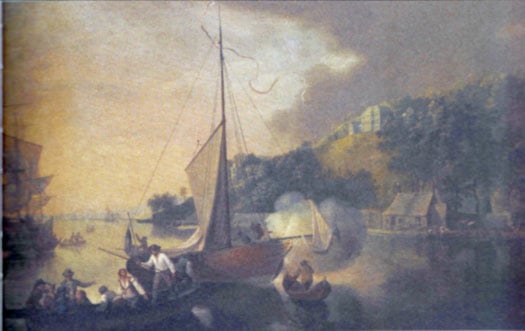
The best way to get the crew on board....on upper Cork Harbour at Tivoli in 1765, a yacht of the reviving Water Club fires a gun to signal imminent departure.
However, it was on Ireland's inland waterways that the next club appeared – Lough Ree Yacht Club came into being in 1770, and is still going strong. That same year, one of the earliest yacht clubs in England appeared at Starcross in Devon, but it was in London that the development pace was being most actively set with racing in the Thames for the Cumberland Fleet. Some members of this group, after the usual arguments and splits which plague any innovative organisation, in due course re-formed themselves as the Royal Thames Yacht Club in the early 1800s. But the famous yet unattributed painting of the Cumberland Fleet racing on the Thames in 1782, while it is slightly reminiscent of Monamy's painting of the Water Club 44 years earlier, undoubtedly shows boats racing. And they'd rules too – note the port tack boat on the right of the picture bearing off to give way to the boat on starboard.
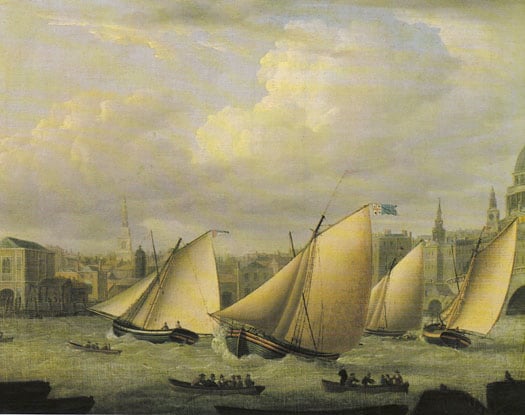
Definitely racing – the Cumberland Fleet, precursor of the Royal Thames Yacht Club, racing in the River Thames at Blackfriars in 1782.
The Thames was wider in those days, but even so they needed strict rules to make racing possible. Dublin Bay offered more immediate access to open water, and there were certainly sailing pleasure boats about. When the Viceroy officially opened the Grand Canal Dock on April 23rd 1796, it was reported that the Viceregal yacht Dorset was accompanied by a fleet of about twenty ceremonial barges and yachts. Tantalisingly, the official painting is almost entirely focused on the Dorset and her tender, while the craft in the background seem to be naval vessels or revenue cutters.
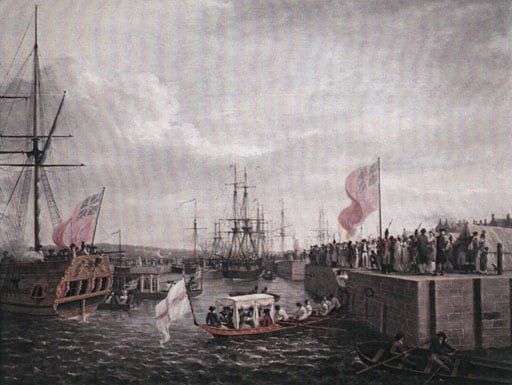
This painting of the opening of the Grand Canal Dock in 1796 tends to concentrate on the ceremonials around the Viceroy's yacht Dorset in the foreground, but fails to show clearly any of the several privately-owned yachts which were reportedly also present....
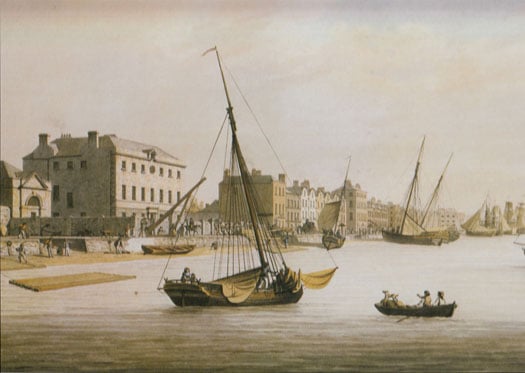
.......but this illustration of the old Marine School on the South Quays in Dublin in 1803 seems to have a yacht – complete with owner and his pet dog on the dinghy in the foreground – anchored at mid-river.
However, a Malton print of the Liffey in 1803 shows clearly what is surely a yacht, the light-hearted atmosphere of waterborne recreation being emphasised by the alert little terrier on the stern of the tender conveying its owner in the foreground Meanwhile in the north of Ireland there was plenty of sailing space in Belfast Lough, while Belfast was a centre of all sorts of innovation and advanced thinking. Henry Joy McCracken, executed for his role in the United Irishmen's rising in 1798, was a keen pioneer yachtsman. As things took a new turn of determined money-making in Belfast after the Act of Union of 1801, some of his former crewmates were among those who formed the Northern Yacht Club in 1824, though it later transferred its activities across the North Channel to the Firth of Clyde, and still exists as the Royal Northern & Clyde YC.
Meanwhile in 1806 the old Water Club of the Harbour of Cork had shown new signs of life, but one result of this was an eventual agreement among members - some of them very old indeed, some representing new blood - that the club would have to be re-structured and possibly even given a new name in order to reflect fresh developments in the sport of yachting. The changeover was a slow business, as it had to honour the club's history while giving the organisation contemporary relevance. Thus it was 1828 before the Royal Cork Yacht Club had emerged in this fully fledged new form, universally acknowledged as the continuation of the Water Club, and incorporating much of its style.
But it was across the north on Lough Erne in 1820 that the world's first yacht club specifically set up to organise racing was formed, and Lough Erne YC continues to prosper today, its alumnae since 1820 including early Olympic sailing medallists and other international champions.
There must have been something in the air in this northwest corner of Ireland in the 1820s, for in 1822 the men who sailed and raced boats on Lough Gill at Sligo had a pleasant surprise. Their womenfolk got together and raised a subscription for a handsome silver trophy to be known as the Ladies' Cup, to be raced for annually – and it still is.
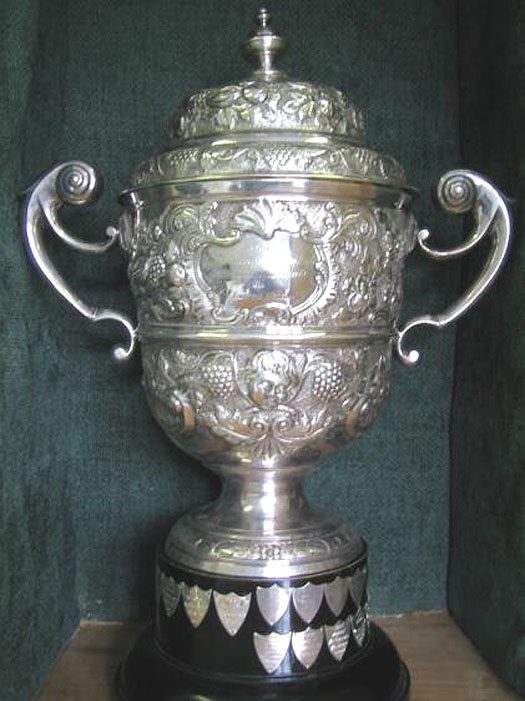
Instituted in 1822, the Ladies' Cup of Sligo YC is the world's oldest continually-contested annual sailing trophy.
Annual challenge cups now seem such a natural and central part of the sailing programme everywhere that it seems extraordinary that a group of enthusiastic wives, sisters, mothers and girlfriend in northwest Ireland were the first to think of it, yet such is the case. Or at least theirs is the one that has survived for 192 years, so its Bicentenary in 2022 is going to be something very special.
Those racing pioneers of the Cumberland Fleet had made do with new trophies freshly presented each year. And apparently the same was the case initially at Lough Erne. But not so very far down the road, at Sligo, somebody had this bright idea which today means that the museum in Sligo houses the world's oldest continually raced-for sailing trophy, and once a year it is taken down the road to the Sligo YC clubhouse at Rosses Point to be awarded to the latest winner – in 2013, it was the ever-enthusiastic Martin Reilly with his Half Tonner Harmony.
The Ladies Cup was won in 2013 by Martin Reilly's Half Tonner Harmony. Pictured with their extremely historic trophy are (left to right) Callum McLoughlin, Mark Armstrong, Martin Reilly, John Chambers, Elaine Farrell, Brian Raftery and Gilbert Henry
However, although the Ladies' Cup may have pioneered a worthwhile trend in yacht racing, it wasn't until 1831 that they thought of inscribing the name of the winner, and that honour goes to Owen Wynne of Hazelwood on the shores of Lough Gill. But by that time the notion of inscribing the winners was general for all trophies, and a noted piece of the collection in the Royal Cork is the Cork Harbour Regatta Cup 1829, and on it is inscribed the once-only winner, Caulfield Beamish's cutter Little Paddy.
The name of noted owner, skipper and amateur yacht designer Caulfield Beamish came up here some time back, when we were discussing how in 1831 he took a larger new yacht to his own design, the Paddy from Cork, to Belfast Lough where he won a stormy regatta. So you begin to understand the mysterious enthusiasm people have for sacred relics when you see this cup with its inscription, and realise that it's beyond all doubt that this now-forgotten yet brilliant pioneer of Cork Harbour sailing development personally held this piece of silverware.
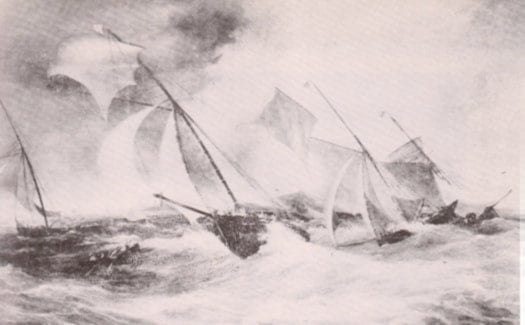
Caulfield Beamish's new cutter Paddy from Cork (which he designed himself) winning a stormy regatta in Belfast Lough in 1831
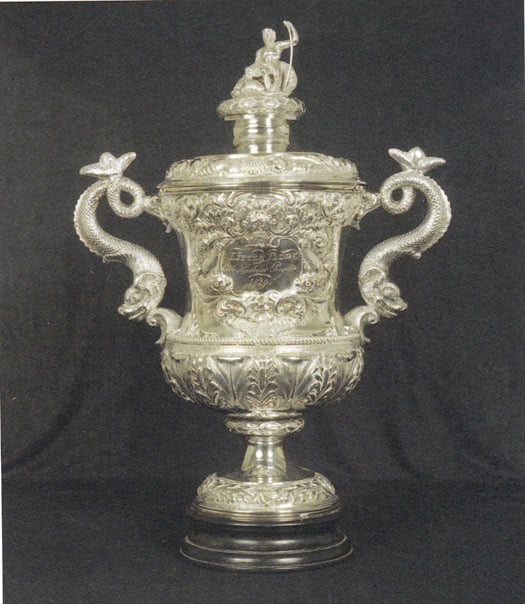
The Cork Harbour Regatta Cup of 1829.....Courtesy RCYC
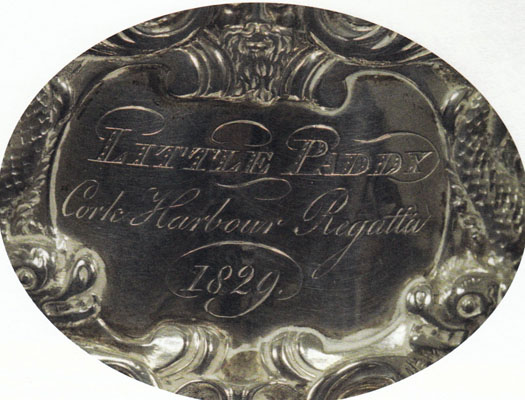
....and on it is inscribed the winner, Caulfield Beamish's earlier boat, Little Paddy, which he also designed himself. Courtesy RCYC
Another pioneer in yacht racing at the time was the Knight of Glin from the Shannon Estuary, who in 1834 was winning all about him with his cutter Rienvelle, his season's haul including a silver plate from a regatta in Galway Bay – it's now in Glin Castle – while he also seems to have relieved fellow Limerick owner William Piercy of £50 for a match race in Cork Harbour against the latter's cutter Paul Pry.
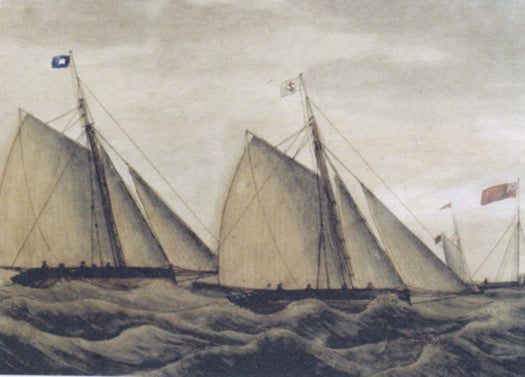
The lads from Limerick hit Cork. William Piercy's Paul Pry racing for a wager of £50 against the Knight of Glin's Rienvelle in Cork Harbour in 1834. When Paul Pry won Cork Harbour Regatta a few weeks later, the band on the Cobh waterfront played Garryowen. Courtesy RCYC
But of all the fabulous trophies in the Royal Cork collection, the one which surely engenders the most affection is the Kinsale Kettle. It goes back "only" to 1859, when it was originally the trophy put up for Kinsale Harbour Regatta. But this extraordinarily ornate piece of silverware was not only the trophy for an annual race, it was also the record of each race, as it's inscribed with brief accounts of the outcomes of those distant contests.
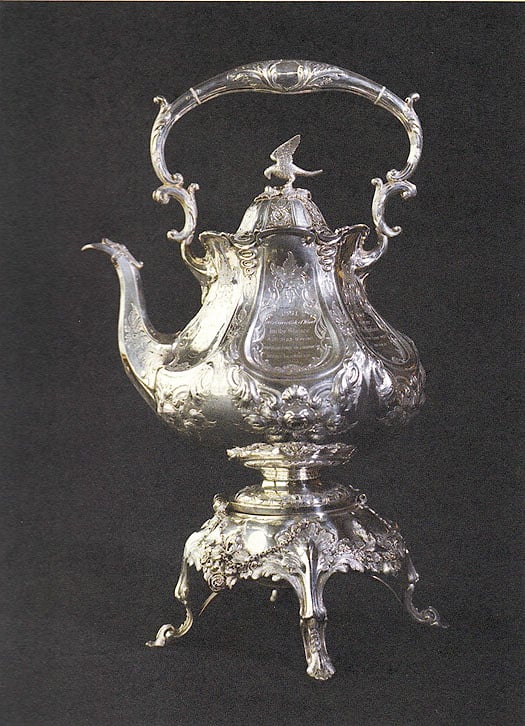
An extraordinary piece of Victorian silverware. The "Kinsale Kettle" from 1859 is now the Royal Cork YC's premier trophy.
Today, it continues to thrive as the Royal Cork Cup, the premier award for Cork Week. The most recent winner in 2012 was Piet Vroon with his superb and always enthusiastic Tonnere de Breskens. The fact that this splendid ambassador for Dutch sailing should be playing such a central role in current events afloat here in Ireland brings the story of our sport's artworks and historical artefacts to a very satisfactory and complete circle.
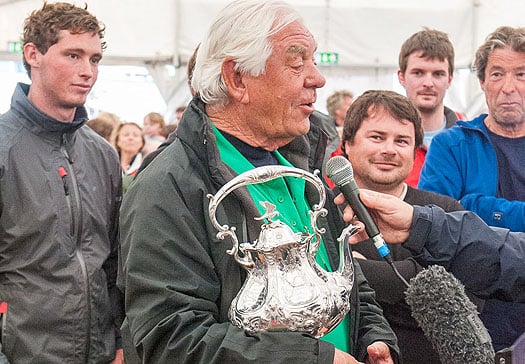
More tea, skipper? The current holder of the Kinsale Kettle, aka the Royal Cork Cup, is Piet Vroon of Tonnere de Breskens. Photo: Bob Bateman
O'Driscoll retains J24 title at Lough Erne
Flor O’Driscoll and his crew on ‘Hard on Port’ successfully defended their Irish J24 Championship title at Lough Erne last weekend but they were pushed hard all the way by the two McCaldins, Mickey and son JP, from the host club.
The eight-race championship, sponsored by Waterways Ireland, was sailed in a wide variety of wind strengths, with rain showers a feature on both days and particularly heavy conditions for the final race.
O’Driscoll, from the Royal St.George YC but sailing out of Howth this year in readiness for the forthcoming Europeans there, started slowly by his standards with a 3rd and 4th while the McCaldins took it in turns to cross the line first. He got more into his stride in race three and five with bullets but had an OCS in race 4, ultimately his discard.
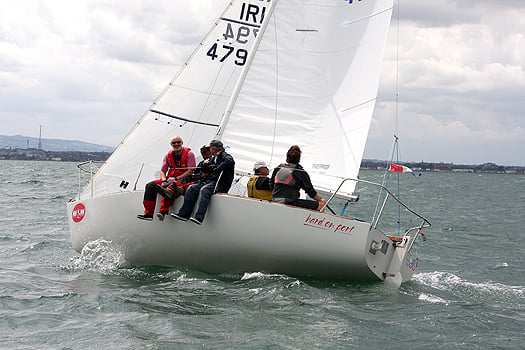
Flor O'Driscoll's Hard on Port was the winner of the weekend J24 Nationals
Andrew Mannion of Lough Ree YC sailing ‘Jeb Stuart’ won the fourth race comfortably while a former champion Stefan Hyde on ‘Kilcullen’ took the last race of the day.
With the McCaldins the only major threat, O’Driscoll sailed two tactically clever races to ensure that neither could overtake his lead, finishing second to Mickey in race 7 and one place (4th) ahead of JP in the final race (won by Stefan Hyde again). After discards, he had a 7-point margin of victory, a reward for consistently finishing in the top three in six of eight races.
The 16-boat event also included a separate trophy for the ‘silver fleet’ which was won by Javelin (Stan Bradbury) from Lough Ree YC.
Waterways Ireland Irish J24 National Championships – Lough Erne YC
- Hard on Port Flor O’Driscoll RSt.GYC 17 points
- Murder Picture Mickey McCaldin LEYC 24 points
- Jamais Encore JP McCaldin LEYC 25 points
- Kilcullen Stefan Hyde RCYC 26 points
- Sayanara Martin Darrer RCYC 26 points
- Jeb Stuart Andrew Mannion LRYC 34 points
O'Driscoll Domination of J24 Fleet Continues
The stranglehold that Flor O'Driscoll and his crew on 'Hard on Port' from the Royal St.George Yacht Club seem to have on the Irish J/24 Class was maintained with yet another win, this time the Northern Championships hosted by Lough Erne Yacht Club on August 7th/8th, writes Graham Smith.
After a slow start, with a 4th and 6th in the first two races, the Dun Laoghaire boat showed her transom to the other 11 boats in the fleet over the remaining four races in varied wind conditions. The result was an emphatic win by ten points from the runner-up, J.P.McCaldin of the host club sailing 'Jamais Encore'.
Class President Robin Eagleson sailed so consistently on his veteran 'Luder Too' that he tied on points with 'Jamais Encore' and only lost out on a countback, an impressive result considering a 30-year gap in the boats' ages. Third overall and winning the Silver Fleet award for the older J/24s was just reward for an outstanding series.
Current National Champion Mickey McCaldin ('Murder Picture') was consistently in the top six but never really got going and had to settle for 4th overall while the same could be said of Brian McDowell's 'Scandal' from Malahide in 5th place. 'Javlin' (Stan Bradbury from Lough Ree YC) started the event with a bang, recording a 1st and 2nd in the opening races, but two OCSs later on put paid to their chances.
Having already won the Western Championships at Lough Ree in mid-June and an impressive 2nd overall in Class 3 at the ICRA Nationals on Dublin Bay, Flor O'Driscoll and his crew are looking the outstanding favourites to add the national title to their year's tally.
The 2-day event takes place on September 11th/12th at Howth Yacht Club, venue for the J/24 European Championships next year. It will provide J/24 sailors, especially those from the inland lake clubs, to familiarise themselves with the tidal Howth waters before the big event in 2011.
Lough Erne Yacht Club
Lough Erne Yacht Club now occupies a former WW2 RAF site built in 1941 for Catalina flying boats
The former slipway, moorings and hangar are now used for members' sailing boats, power boats and caravans. The Clubhouse, with changing rooms, bar and social facilities was built in the 1960s & 1980s. A marina containing berths with full water and electricity was completed in 1992 and an extension with space for an additional 28 berths has recently been added.
WWII History of LEYC
Winter 1940 brought flying boats to Gublusk Bay. RAF Stranraer had been set up in August, but Lough Erne was over a hundred miles closer to the mid-Atlantic, where air cover was urgently needed by convoys under attack from U-boats.
Two boats from Stranraer surveyed the Lough from the air at Christmas. In January, the Free State Government secretly allowed flying straight to the Atlantic via the Donegal Corridor. In February, RAF Stranraer’s 209 and 240 Squadrons were re-equipping and training with Catalinas, and began to use Lough Erne. These handy aircraft carried a full service kit so their crews could set up a first base quickly on any sheltered beach. Thus did RAF Killadeas begin along the sheltered north shore of Gublusk Bay, nowadays the home of our Lough Erne Yacht Club.
The first photograph shows Catalinas on Gublusk shore in mid-winter 1941, engines under corrugated iron canopies for servicing, a hospital under construction on land north to the Manor House, and a big boat shed, half built – today called the Hangar. A hatched line marks the edge of the planned concrete hard standing. The work was done by US servicemen under Ivan Bicklehaupt USN, in civilian clothing. A couple of years later, his men used Killadeas experiences as similar US Navy Catalina forward bases were set up on Pacific island beaches in the Japanese war.
On 12 March, first casualties were all of a 240 squadron crew in a Catalina out of RAF Killadeas that hit a hill and burnt in Leitrim. On 27 March, 209 and 240 transferred from Stranraer to RAF Killadeas. Another 240 crew were all lost on 7 May when a Catalina from RAF Killadeas crashed in flames mistaking a landing onto mirror-calm water near Gay Island. They are remembered today by one of Joe O’Loughlin’s memorial stones nearby at the Marina beacon.
Training was rewarded three weeks later on 26 May, when a Catalina from 209 found the Bismarck on her way to France after sinking the Hood, and handed over to another from 240 to follow this dangerous battleship. She was sunk next day. Thereafter, for the crews of the Catalinas, and the Sunderlands from Castle Archdale, the war was rarely so glamorous, but often dangerous, uncomfortable and boring. They flew whatever the weather. Landing in summer sunshine from clear air to calm water was a puzzling danger. Navigation, hundreds of miles off-shore was another dangerous puzzle, particularly in the dark, freezing, blinding fury of winter Atlantic gales and driving snow storms.
A few planes were shot down. Many flew out and did not return. Perhaps fifty crashed on coastal headlands in the lough or on inland hilltops. Joe O’Loughlin recorded 330 casualties onto Rolls of Honour by Catalina, Sunderland and land plane, and presented these on Remembrance Sunday 2005 for display at LEYC, Castle Archdale and St Angelo.
RAF Killadeas expanded in mid-1942 to include OTU 131, an Operational Training Unit, where individual pilots, navigators, gunners and radio operators, trained in Galloway and elsewhere, became crews and learned to operate together patrolling the Atlantic hunting submarines in Catalinas, and later in Sunderlands. RAF Killadeas became a big place, with accommodation for 2,800 RAF personnel, and a new Catalina slipway on the east shore of Gublusk Bay.
Most from OTU 131 were posted elsewhere. Canadian pilot, Bud Crooks, who unveiled Joe O’Loughlin’s OTU 131 memorial stone at LEYC Flagstaff in 2000, remembered flying his Sunderland to the Far East after training. When the war ended, and its longest running battle, the Battle of the Atlantic, RAF Killadeas closed down, leaving surplus buildings and scrap aircraft, boats, tools and equipment. A plan to make the site into a Butlin’s Holiday Camp did not happen. Corrugated iron scrap from buildings was sold to Belfast, and some used for Casement Park GAA stadium.
LEYC has been on the site since 1950. Likewise, Stranraer Sailing Club is on the old RAF slipway there. Our historic Fairy keelboats have wintered in the Hangar for over 50 years, a major reason for their survival to centenary in 2006. In summer, they launch down a WW2 slipway to lie on flying boat moorings, while hoisting their 1906 gunter mainsails. Catalina service bays now hold the RNLI Station, LEYC’s BBQ and children’s dinghy racks. Rings that held Catalinas down in gales now secure catamarans. The refuelling jetty snugly berths a barge. Peace now, where once was war.
A
second picture show Catalinas over RAF Killadeas about 1943, left
foreground is the amphibian Catalina slipway under construction, with
boats and aircraft in Gublusk Bay and around, and Devenish in the
distance. A third shows Doreen, about 45 years later, moored by a chain
to a clump on the bottom made for flying boats, her crew raising sail.
Copies of longer reports in the local Fermanagh press and loan of a DVD of the ceremony at LEYC are available.
Michael Clarke, LEYC Historian, Email [email protected]
'Sailing History of Lough Erne' is the title of an article in the local history journal, Clogher Record, 2005 edition
A century ago, the grand Crom era in LEYC’s history was at its height. A water-colour from then, showing a becalmed Two-Rater racing yacht off Crom Castle, graces the front cover of this 2005 editionof the Clogher Record.
Inside The Sailing History of Lough Erne is set out in 40 pages, from the Maguires in the 1500s, to Big Houses and ‘pretty yachts’ in the 1700s, to yacht racing’s 1818 pioneers, The Subscribers to the Boat Races on Lough Erne, for the encouragement of fast Sailing Boats, and for the improvement of the Navigation, then Two-Raters, Colleens and Fairy keelboats, Enniskillen Yacht Club, and today’s LEYC sited on the former WW2 flying boat base RAF Killadeas.
The Clogher Record, journal of the Clogher Historical Society, is circulated to its members and to many universities, libraries, museums and historical societies. The then LEYC Admiral, John Phillips acepted a copy presented to the Club which is in the Secretary's files and available to members. Ther is also a copy in Enniskillen Library, local history collection.
The club is located on Lower Lough Erne, Co Fermanagh, about 6 miles
north of Enniskillen just off the main Enniskillen- Kesh-Belleek Road.
LEYC has a long history of competitive sailing at a national and international level and was one of the first clubs in Northern to achieve the national standard of Volvo RYA Champion Club in 2002 To gain the award, clubs must operate an approved scheme of youth sailing and race coaching which both introduces young people to sailing and helps them compete at different levels up to international standard.
The club has active J24, GP14, Laser and Topper fleets as well as a fleet of classic wooden sailing boats designed by Linton Hope known as the Fairies. LEYC hosts a number of major sailing events each year and its superb facilities, including a pillar crane for smaller boats and a straddle hoist for the larger boats and spacious camping and parking areas are much appreciated by visiting fleets
A large fleet of sailing cruisers, motor cruisers and smaller boats is also based at the LEYC with immediate access to the glorious cruising waters of the Erne Lakeland. With over 250 active members, there is a full sailing and social calendar every season. To apply for membership, contact [email protected]. To enquire about courses, Try Sailing, or other information contact [email protected]
Lough Erne Yacht Club, Gublusk Bay, Co Fermanagh BT94 1NZ. Tel: 028 66388432, fax: 028 66389857, email:[email protected]
Have we got your club details? Click here to get involved





























